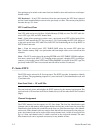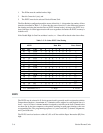
5-5Vertical Format Units
Table 5-2. P-Series EVFU Codes - PI Line Disabled or Not Used
Hex
10
11
12
13
14
15
16
17
18
19
1A
1B
1C
1D
1E
1F
76 5 4 3 21
0
0
0
0
0
0
0
0
0
0
0
0
1
1
1
1
1
1
1
1
0
0
0
0
1
1
1
1
0
0
0
0
1
1
1
1
0
0
1
1
0
0
1
1
0
0
1
1
0
0
1
1
0
1
0
1
0
1
0
1
0
1
0
1
0
1
0
1
1 (TOF)
2
3
4
5
6
7
8
9
10
11
12 (VT)
13
14
Start Load
End Load
Dec
16
17
18
19
20
21
22
23
24
25
26
27
28
29
30
31
1
1
1
1
1
1
1
1
1
1
1
1
1
1
1
1
X = Undefined, 0 or 1 1 = High 0 = Low
ASCII ChannelData Bits
8
0
0
0
0
0
0
0
0
0
0
0
0
0
0
0
0
0
0
0
0
0
0
0
0
0
0
0
0
0
0
0
0
0
0
0
0
0
0
0
0
0
0
0
0
Code
DLE
DC1
DC2
DC3
DC4
NAK
SYN
ETB
CAN
EM
SUB
ESC
FS
GS
RS
US
NOTE: The ESC code cannot be used simultaneously as the EVFU VT code and the
Special Function Control Character (SFCC). If ESC is used as the SFCC, the EVFU
must
be used with the PI line enabled and set high.
R
efer to the Configuration chapter for
more
information on the SFCC
.
Clearing the EVFU Memory
The
following actions will reset (clear) the EVFU memory:
1.
Sending only the start load code.
2.
Sending a start load code followed immediately by an end load code.
3. A second start load code is received, resulting in reinitialization of the EVFU. (This alĆ
lows
the host data to be restarted.)
When the EVFU memory is cleared, the forms length returns to the previously set value and
the
current print position becomes the top-of-form (TOF).
Relative Line Slewing
Another
method of moving paper using the PI
line results in vertical slews of a specified num
Ć
ber of lines within the form relative to the current print line (rather than slewing to a specific
line).
F
or this to occur, three criteria must be met:


















